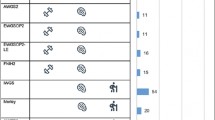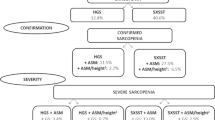Abstract
Objectives
Sarcopenia is a debilitating condition affecting millions of individuals worldwide and is defined with different criteria. The objective of this study was to determine the prevalence of sarcopenia in older Canadians using three internationally accepted criteria.
Design
Observational cohort study.
Settings and participants
Data from 12,592 subjects [6,314 males (50.1%), 6,278 females (49.9%)] ≥65 years old in the Canadian Longitudinal Study on Aging were included. Measurements: Appendicular lean mass (ALM; kg) and appendicular lean mass index (ALM kg/height in m2) were collected from dual X-ray absorptiometry measurements. Physical performance was assessed using the 4-m gait speed test, and muscle strength was measured by hand dynamometry. Sarcopenia was defined according to criteria put forth by the International Working Group on Sarcopenia (IWGS), Foundation for the National Institutes of Health (FNIH) Sarcopenia Project, and revised European Working Group on Sarcopenia in Older People (EWGSOP). Positive and negative percent agreements and Cohen’s kappa (κ) described the agreement among sarcopenia definitions.
Results
Among the evaluated criteria, gait speed ≤ 1.0 m/s (IWGS definition of slowness) was the most frequently identified deficit (56.8% males, 57.2% females). The prevalence of sarcopenia ranged from 1.4 to 5.2% in males and 1.6 to 7.2 % in females among the different definitions. Positive percent agreement values among criteria were generally low (range: 1.5–55.3%) and corresponded to κ indicating none to minimal agreement (0.01–0.23). Negative percent agreement values were ≥ 95%.
Conclusion
Sarcopenia prevalence was relatively low in older Canadian adults and current definitions had poor agreement in diagnosing individuals as sarcopenic.

Similar content being viewed by others
References
Statistics Canada. Census Profile 2016. Statistics Canada Catalogue No. Doi: 98-316-X2016001.
Statistics Canada. Population Projections for Canada (2013 to 2063), Provinces and Territories (2013 to 2038). Ottawa; 2016.
Janssen I., Shepard DS., Katzmarzyk PT., Roubenoff R. The healthcare costs of sarcopenia in the United States. J Am Geriatr Soc 2004;52(1):80–5.
Castillo EM., Goodman-Gruen D., Kritz-Silverstein D., Morton DJ., Wingard DL., Barrett-Connor E. Sarcopenia in elderly men and women: the Rancho Bernardo study. Am J Prev Med 2003;25(3):226–31.
Bales CW., Ritchie CS. Sarcopenia, weight loss, and nutritional frailty in the elderly. Annu Rev Nutr 2002;22:309–23. Doi: https://doi.org/10.1146/annurev.nutr.22.010402.102715.
Beaudart C., Rizzoli R., Bruyère O., Reginster J-Y., Biver E. Sarcopenia: burden and challenges for public health. Arch Public Health 2014;72(1):45. Doi: https://doi.org/10.1186/2049-3258-72-45.
Cruz-Jentoft AJ., Bahat G., Bauer J., et al. Sarcopenia: revised European consensus on definition and diagnosis. Age Ageing 2019;48(1):16–31. Doi: https://doi.org/10.1093/ageing/afy169.
Fielding RA., Vellas B., Evans WJ., et al. Sarcopenia: An Undiagnosed Condition in Older Adults. Current Consensus Definition: Prevalence, Etiology, and Consequences. International Working Group on Sarcopenia. J Am Med Dir Assoc 2011;12(4):249–56. Doi: https://doi.org/10.1016/j.jamda.2011.01.003.
Studenski SA., Peters KW., Alley DE., et al. The FNIH sarcopenia project: rationale, study description, conference recommendations, and final estimates. J Gerontol A Biol Sci Med Sci 2014;69:547–58. Doi: https://doi.org/10.1093/gerona/glu010.
Mayhew AJ., Amog K., Phillips S., et al. The prevalence of sarcopenia in community-dwelling older adults, an exploration of differences between studies and within definitions: a systematic review and meta-analyses. Age Ageing 2019;48(1):48–56. Doi: https://doi.org/10.1093/ageing/afy106.
Barbosa-Silva TG., Bielemann RM., Gonzalez MC., Menezes AMB. Prevalence of sarcopenia among community-dwelling elderly of a medium-sized South American city: results of the COMO VAI? study. J Cachexia Sarcopenia Muscle 2016;7(2):136–43. Doi: https://doi.org/10.1002/jcsm.12049.
Raina PS., Wolfson C., Kirkland SA., et al. The Canadian longitudinal study on aging (CLSA). Can J Aging 2009;28(3):221–9. Doi: https://doi.org/10.1017/S0714980809990055.
Kirkland SA., Griffith LE., Menec V., et al. Mining a Unique Canadian Resource: The Canadian Longitudinal Study on Aging. Can J Aging 2015;34(3):366–77. Doi: https://doi.org/10.1017/S071498081500029X.
World Health Organisation. WHO | Deaths from NCDs. WHO 2015. Available at https://www.who.int/gho/ncd/mortality_morbidity/ncd_total_text/en/. Accessed February 19, 2020
Manini TM., Clark BC. Dynapenia and aging: an update. J Gerontol A Biol Sci Med Sci 2012;67:28–40. Doi: https://doi.org/10.1093/gerona/glr010.
Clark BC., Manini TM. What is dynapenia? Nutrition 2012;28(5):495–503. Doi: https://doi.org/10.1016/j.nut.2011.12.002.
Rosenberg IH. Summary comments. Am J Clin Nutr 1989;50(5): 1231–3. Doi: https://doi.org/10.1093/ajcn/50.5.1231.
Prado CM., Purcell SA., Alish C., et al. Implications of low muscle mass across the continuum of care: a narrative review. Ann Med 2018;50(8). Doi: https://doi.org/10.1080/07853890.2018.1511918.
McLean RR., Shardell MD., Alley DE., et al. Criteria for clinically relevant weakness and low lean mass and their longitudinal association with incident mobility impairment and mortality: the foundation for the National Institutes of Health (FNIH) sarcopenia project. J Gerontol A Biol Sci Med Sci 2014;69(5):576–83. Doi: https://doi.org/10.1093/gerona/glu012.
Ferrucci L., Guralnik JM., Buchner D., et al. Departures from linearity in the relationship between measures of muscular strength and physical performance of the lower extremities: the Women’s Health and Aging Study. J Gerontol A Biol Sci Med Sci 1997;52(5):M275–85. Doi: https://doi.org/10.1093/gerona/52a.5.m275.
Chen L., Nelson DR., Zhao Y., Cui Z., Johnston JA. Relationship between muscle mass and muscle strength, and the impact of comorbidities: a population-based, cross-sectional study of older adults in the United States. BMC Geriatr 2013;13:74. Doi: https://doi.org/10.1186/1471-2318-13-74.
Martín-Ponce E., Hernández-Betancor I., González-Reimers E., Hernández-Luis R., Martínez-Riera A., Santolaria F. Prognostic value of physical function tests: hand grip strength and six-minute walking test in elderly hospitalized patients. Sci Rep 2014;4:7530.
Studenski S., Perera S., Patel K., et al. Gait Speed and Survival in Older Adults. JAMA 2011;305(1):50–8. Doi: https://doi.org/10.1001/jama.2010.1923.
Leong DP., Teo KK., Rangarajan S., et al. Prognostic value of grip strength: findings from the Prospective Urban Rural Epidemiology (PURE) study. Lancet (London, England) 2015;386(9990):266–73. Doi: https://doi.org/10.1016/S0140-6736(14)62000-6.
Cawthon PM., Fox KM., Gandra SR., et al. Do Muscle Mass, Muscle Density, Strength, and Physical Function Similarly Influence Risk of Hospitalization in Older Adults? J Am Geriatr Soc 2009;57(8): 1411–9. Doi: https://doi.org/10.1111/j.1532-5415.2009.02366.x.
Norman K., Stobäus N., Gonzalez MC., Schulzke J-D., Pirlich M. Hand grip strength: Outcome predictor and marker of nutritional status. Clin Nutr 2011;30(2):135–42. Doi: https://doi.org/10.1016/j.clnu.2010.09.010.
Alexandre T da S., Duarte YADO., Santos JLF., Wong R., Lebrao ML. Sarcopenia according to the European Working Group on Sarcopenia in Older People (EWGSOP) versus dynapenia as a risk factor for mortality in the elderly. J Nutr Health Aging 2014;18(8):751–6. Doi: https://doi.org/10.1007/s12603-014-0540-2.
Dam T-T., Peters KW., Fragala M., et al. An evidence-based comparison of operational criteria for the presence of sarcopenia. J Gerontol A Biol Sci Med Sci 2014;69(5):584–90. Doi: https://doi.org/10.1093/gerona/glu013.
Reijnierse EM., Trappenburg MC., Leter MJ., et al. The Impact of Different Diagnostic Criteria on the Prevalence of Sarcopenia in Healthy Elderly Participants and Geriatric Outpatients. Gerontology 2015;61(6):491–6. Doi: https://doi.org/10.1159/000377699.
Cruz-Jentoft AJ., Baeyens JP., Bauer JM., et al. Sarcopenia: European consensus on definition and diagnosis: Report of the European Working Group on Sarcopenia in Older People. Age Ageing 2010;39:412–23. Doi: https://doi.org/10.1093/ageing/afq034.
Locquet M., Beaudart C., Petermans J., Reginster J-Y., Bruyère O. EWGSOP2 Versus EWGSOP1: Impact on the Prevalence of Sarcopenia and Its Major Health Consequences. J Am Med Dir Assoc 2019;20(3):384–5. Doi: https://doi.org/10.1016/j.jamda.2018.11.027.
Yang L., Yao X., Shen J., et al. Comparison of revised EWGSOP criteria and four other diagnostic criteria of sarcopenia in Chinese community-dwelling elderly residents. Exp Gerontol 2020;130:110798. Doi: https://doi.org/10.1016/j.exger.2019.110798.
Phu S., Vogrin S., Zanker J., Bani Hassan E., Al Saedi A., Duque G. Agreement Between Initial and Revised European Working Group on Sarcopenia in Older People Definitions. J Am Med Dir Assoc 2019;20(3):382–383.el. Doi: https://doi.org/10.1016/j.jamda.2018.11.026.
Kim M., Won CW. Prevalence of sarcopenia in community-dwelling older adults using the definition of the European Working Group on Sarcopenia in Older People 2: findings from the Korean Frailty and Aging Cohort Study. Age Ageing 2019;48(6):910–6. Doi: https://doi.org/10.1093/ageing/afz091.
Sobestiansky S., Michaelsson K., Cederholm T. Sarcopenia prevalence and associations with mortality and hospitalisation by various sarcopenia definitions in 85–89 year old community-dwelling men: a report from the ULSAM study. BMC Geriatr 2019;19(1):318. Doi: https://doi.org/10.1186/s12877-019-1338-1.
Murphy CH., Mcmorrow AM., Flanagan EM., et al. SUN-LB651: Prevalence of Sarcopenia in Community-Dwelling Older Adults in Ireland: Comparison of EWGSOP1 and EWGSOP2 Definitions. Clin Nutr 2019;38:S301. Doi: https://doi.org/10.1016/S0261-5614(19)32617-2.
Heymsfield SB., Peterson CM., Thomas DM., Heo M., Schuna Jr JM. Why are there race/ethnic differences in adult body mass index-adiposity relationships? A quantitative critical review. Obes Rev 2016;17(3):262–75. Doi: https://doi.org/10.1111/obr.12358.
Statistics Canada. Table 13-10-0096-20 Body mass index, overweight or obese, self-reported, adult, age groups (18 years and older). Canadian Community Health Survey - Annual Component.
Bauer J., Morley JE., Schols AMWJ., et al. Sarcopenia: A Time for Action. An SCWD Position Paper. J Cachexia Sarcopenia Muscle 2019. Doi: https://doi.org/10.1002/jcsm.12483.
Tessier A-J., Wing SS., Rahme E., Morais JA., Chevalier S. Physical function-derived cut-points for the diagnosis of sarcopenia and dynapenia from the Canadian longitudinal study on aging. J Cachexia Sarcopenia Muscle 2019;0(0). Doi: https://doi.org/10.1002/jcsm.12462.
Funding
Funding: This work (specifically, data from the CLSA) was supported by the Government of Canada through the Canadian Institutes of Health Research (CIHR) under grant reference: LSA 9447 and the Canada Foundation for Innovation. The CLSA is led by Drs. Parminder Raina, Christina Wolfson and Susan Kirkland. This work was also supported by a CIHR Catalyst Grant FRN 151279. C. M. Prado is supported by a Canadian Institutes of Health Research (CIHR) New Investigator Salary Award and the Campus Alberta Innovates Program.
Author information
Authors and Affiliations
Contributions
Author contributions: Study concept and design: ID, MS, CMP. Acquisition of data: CMP. Analysis and interpretation of data: All authors. Drafting of the manuscript: MM and SAP. Critical revision of the manuscript for important intellectual content: All authors.
Corresponding author
Ethics declarations
Ethical standards: This investigation was approved by the Research Ethics Office at the University of Alberta (Study ID Pro00070975). All participants provided written informed consent and data were de-identified before analyses by the study team.
Conflicts of interest: The authors have no conflicts of interests to declare.
Electronic supplementary material
Rights and permissions
About this article
Cite this article
Purcell, S.A., Mackenzie, M., Barbosa-Silva, T.G. et al. Sarcopenia Prevalence Using Different Definitions in Older Community-Dwelling Canadians. J Nutr Health Aging 24, 783–790 (2020). https://doi.org/10.1007/s12603-020-1427-z
Received:
Accepted:
Published:
Issue Date:
DOI: https://doi.org/10.1007/s12603-020-1427-z




